Russian Orthodox Autonomous
Church
This
web-site is not official
It is presently under construction
BISHOPS
Metropolitan
Valentine
of Suzdal and Vladimir
First-Hierarch of Russian Orthodox Autonomous
Church
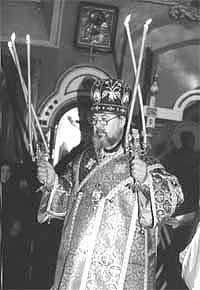 Metropolitan
Valentine of Suzdal and Vladimir (in the world Anatolij Petrovich Rusantsov) was
born on March 3, 1939 in the Belorechensk town, Krasnodar region. His father
died because of war wounds, mother became seriously ill, and Anatoli was sent to
a orphange, from which he was taken as an adopted son to the family of Ekaterina
Buriak, a member of the Catacomb's Christian Chyrch.
Metropolitan
Valentine of Suzdal and Vladimir (in the world Anatolij Petrovich Rusantsov) was
born on March 3, 1939 in the Belorechensk town, Krasnodar region. His father
died because of war wounds, mother became seriously ill, and Anatoli was sent to
a orphange, from which he was taken as an adopted son to the family of Ekaterina
Buriak, a member of the Catacomb's Christian Chyrch.
In 1952 in the course of pilgrimage
around the sacred places of Georgia region in the former USSR, Anatolij met old
monks who gave to him a mainstream in his life. In 1956 he leaves for the city
of Odessa, for the Saint Assumption monastery, where he met Archbishp
Nestor (Anisimov) well-known as a Missionary to Kamchatka, who for a long time
was a bishop of one of the Far-East eparchies of ROCA. Together with him he heft
for Novosibirsk eparchy and was appointed as a psalmreader in the village of the
Great Uluj of Krasnojarsk region.
At Anatolij's request, the
Archbishop Nestor sent him to Holy Spirit monastery of city of Vilnius. In 1958
he became there a monk named Valentine. He was tonsured by Archimandrite
Seraphim (Smykov) who was ordained to priesthood by Metr. Anthiny (Khrapovitski).
In 1960 he became a priest (he was ordained by Archbishop Anthony of Stavropol
and Baku, who was made a bishop by Patriarch Tikhon) and afterwards he fulfilled
his pastoral duty in Stavropol and Vladimir eparchy. In 1970 he obtained a
diploma of the Historical faculty of Dagestan University, in 1973 he graduated
from Moscow Theological College, in 1979 he graduated from Moscow Theological
Academy and obtained the Ph.D. degree.
In 1973 Archimandrite Valentine came
to serve in Suzdal as superior of the Kazan church. He regenerated the
parishÆs life and attracted young people to the Divine services, using his
diplomatic abilities and influence to protect church life from the interference
of the atheist authorities. However, in 1977 the authorities forced the
community to leave the church which was situated on the cityÆs Trade square
and move to another, more distant location. From that time until now Archbishop
Valentine has carried out Divine services in the Emperor Constantine church of
the city of Suzdal. He has passed all these years in unceasing labour to arrange
church life in its struggle both with the atheist authorities and with the
leadership of the MP, which frequently tried to limit the archimandrite in his
efforts to create a strong community of believers in Suzdal instead of a
ōshowcaseö for tourists.
In 1988 the authorities and the
leaders of the Russian Orthodox Church ¢ Moscow Patriarchate raised a
persecution against Archimandrite Valentine, first of all for his unhypocritical
utterances concerning the lack of religious freedom in the USSR during a lecture
tour to America. In spite of numerous protests by believers, Archimandrite
Valentine was retired and it was proposed that he be exiled to a remote village.
Having encountered cynicism and lies in the highest ranks of the Moscow
Patriarchate in the course of these events, Fr. Valentine decided to leave the
MP, since it had unalterably set out on the path of trampling on the holy
canons. He was followed by the believers and clergy of his parish. On April 7,
1990 the departure of the Suzdal believers from the Moscow patriarchate was
completed. On April 11 they were received under the omophorion of the Russian
Church Abroad, and on October 4 Archimandrite Valentine was appointed exarch of
the ROCA on the territory of the USSR.
On February 10, 1991, in the church
of St. Job the Much-Suffering in Brussels, which was a memorial to the Holy
Royal Martyrs, Archimandrite Valentine was consecrated Bishop of Suzdal and
Vladimir. The consecration was carried out by bishops of the Russian Church
Abroad, among them Bishop Gregory Grabbe, who had for many years assisted the
great first-hierarchs of the ROCA and who rendered priceless assistance in the
formation of the Russian [Rossijskoj] Church.
The labour of Bishop Valentine
directed towards the strengthening of the Russian Church, the building up of her
internal life, and the firmness of his position in relation to the MP attracted
to him both the hatred of the patriarchate, the atheists and the
agent-politicians, and the envy of many of his brethren in the episcopate of the
ROCA, who had lost their former spirit of zeal for God. There began a series of
invasions of the canonical territory of the Suzdal Diocese, attempts to tear
parishes away from it and to compromise its president. The Synod of the ROCA set
about examining denunciations of the most absurd content, if they were directed
against Bishop Valentine. In July, 1993, Bishop Valentine was uncanonically and
without any explanation retired by a decision of the Hierarchical Synod of the
ROCA.
In these circumstances Bishop
Valentine took very energetic steps to protect the resurgent Russian Church from
destruction. Without interrupting his efforts to re-establish links with the
ROCA, he created, in March, 1994, the Higher Church Administration of the
Russian Orthodox Church (as stipulated by the order number 362 of Patriarch
Tikhon of All Russia), which took measures to regulate the situation in the
dioceses which had been de facto abandoned to the will of fate by the clerical
leadership of the ROCA. These measures were ardently supported by the people of
the Church, who saw in Bishop Valentine their reliable and wise leader. By a
decision of the HCA Bishop Valentine was raised to the rank of Archbishop.
In the winter of 1994 a temporary
cease-fire with the Synod of the ROCA was effected at the Council in the Lesna
monastery, thanks to the readiness of Archbishop Valentine (who, as a result of
the upheavals he experienced at this council fell seriously ill) to make huge
compromises in the name of ecclesiastical peace. However, soon the insincerity
of the foreign bishops was revealed, and in February, 1995 they heaped
anticanonical bans on the Russian hierarchs. In connection with this, in June,
1995 the Temporary Higher Church Administration of the Russian Church was
re-established under the leadership of Archbishop Valentine. It decided to put
an end to the administrative and canonical submission to the Hierarchical Synod
of the ROCA in view of the numerous canonical violations that had been
introduced into the system. In 1996 the Hierarchical Synod of the Russian
Orthodox Church was created. In this way the Russian Church finally defined its
independent canonical existence as a self-governing part of the local Russian
Church, for which the main credit must go to Archbishop Valentine. On the Synod
meeting on March 2/15, 2001 it was decided that the head of ROAC should be in
the rank of Metropolitan.
In spite of his poor health (he has diabetes, heart problems,
feet problems, etc.), Metropolitan Valentine administers all the affairs subject
to his jurisdiction as Hierarch and First-Hierarch: he defines the general
political course of the Church, cares for the setting in order of parish life
and the selection of worthy candidates for the priesthood, protects the heritage
of the Church before the civil authorities, pays the most careful attention to
the development of spiritual education and a theological school in the Russian
Church, teaches his flock by means of instructive epistles, watches over, and
often personally takes part in, the restoration of church building restored to
the Church. His day starts at 4 A.M. Vladyka daily carries out Divine services
in the churches of Suzdal and regularly carries out pastoral trips throughout
Russian and beyond its boundaries. Metropolitan Valentine pays great paternal
attention to the education of children in the Sunday school attached to the St.
Constantine cathedral.
As unofficial data I can say that our dear Vladyka is really very
good. People either like him very much or (fewer) hate him. But no one can
remind indifferent, because his personality is very strong and unusual. Many more
good things can be said about him.
Archbishop
Theodore
of Borisovsk and Sanino
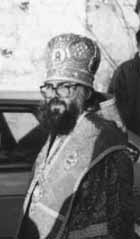 In
the world Vladimir Alexandrovich Gineyevsky. He was born on April 5, 1955. in
the Kuban in Otradnaya stanitsa. In his childhood he was surrounded by catacomb
Christians. In 1972, in Makhachkape, he got to know Archimandrite Valentine (Rusantsov)
and became his spiritual son and irreplaceable assistant over many years. In
1973, he followed Fr. Valentine to Suzdal, where he was appointed reader in the
Kazan church. In 1976 he was tonsured into monasticism. He was later ordained as
hierodeacon and priest of the St. Constantine cathedral in Suzdal, and then was
raised to the rank of abbot. He took a most active part in the labours of
Archimandrite Valentine in the regeneration of church life in Suzdal.
In
the world Vladimir Alexandrovich Gineyevsky. He was born on April 5, 1955. in
the Kuban in Otradnaya stanitsa. In his childhood he was surrounded by catacomb
Christians. In 1972, in Makhachkape, he got to know Archimandrite Valentine (Rusantsov)
and became his spiritual son and irreplaceable assistant over many years. In
1973, he followed Fr. Valentine to Suzdal, where he was appointed reader in the
Kazan church. In 1976 he was tonsured into monasticism. He was later ordained as
hierodeacon and priest of the St. Constantine cathedral in Suzdal, and then was
raised to the rank of abbot. He took a most active part in the labours of
Archimandrite Valentine in the regeneration of church life in Suzdal.
In 1989, after the beginning of persecutions
against Archimandrite Valentine, he signed a petition asking to be retired, and
then, together with Archimandrite Valentine and the Suzdal believers,
transferred to the Russian Church Abroad. He was raised to the rank of
archimandrite, became secretary of the Suzdal Diocesan Administration, and had
undertaken great labours to regulate the life of the diocese.
On March, 19, 1994, in accordance with a decision
of the Temporary Higher Administration of the Russian Orthodox church, he was
consecrated as Bishop of Borisovskoye and Sanino, a vicariate of the Suzdal
Diocese. The consecration was not recognised by the Hierarchical Council of the
ROCA. After the Lesna Council of the ROCA in December, 1994, the foreign bishops
recognised his consecration and invited Bishop Theodore to a session of the
Hierarchical Synod of the ROCA in New York, where anticanonical bans were
unexpectedly placed on Archbishop Valentine and Bishops Theodore and Seraphim.
At the diocesan assembly of the Suzdal Diocese and the sessions of the THCA, it
was decided to cease submission to the Hierarchical Council of the ROCA in view
of its anticanonical line. From 1996 he was secretary, and then chancellor of
the Hierarchical Synod of the Russian Orthodox Church. Archbishop Theodore is
ardently loved by the believers for his kind and simply manner and unfailing
affectionateness. He bears a huge load of administrative work in the diocese and
the Synod, helps Archbishop Valentine in all his labours, and carries out
numerous pastoral journeys.
Archbishop
Seraphim
of Sukhumi and Abkhazia
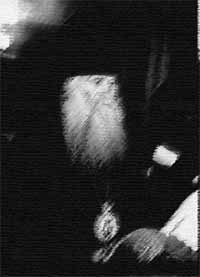 Vladyka Seraphim is a catacomb bishop. Most part of the year he
travels all around Russia, Georgia and other places visiting his parishes. He is
always silent, and he is very modest and simple.
Vladyka Seraphim is a catacomb bishop. Most part of the year he
travels all around Russia, Georgia and other places visiting his parishes. He is
always silent, and he is very modest and simple.
Almost nothing is know about him. He was under the omophorion of
Schema-Bishop Peter (Ladygin) (+1957) in his youth, and at one time he was with
Fr. Michael Rozhdestvensky (+1988)
It is known that he he grew up in catacomb parishes in the Caucasus. Since that he is a very good
climber. In spite of his age, he helped fix roofs in Suzdal. He walked along the roof ridge without the rope slings, and when he needed to go
back, he just jumped, turned back and walked in the opposite
direction.
He knows the book of psalms and the
text of church services by heart. He always prays and he makes wooden crosses for new monks.
Archbishop
Victor
of Daugavpils and Latvia
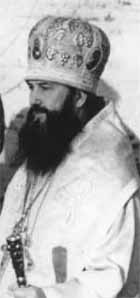 Born
in 1944. In 1988 was tonsured
into monasticism. On June 21, 1995 was consecrated a bishop.
Born
in 1944. In 1988 was tonsured
into monasticism. On June 21, 1995 was consecrated a bishop.
Archbishop Victor it the head of Latvian
Autonomous Orthodox Church in Jurisdiction of Synod of ROAC. Latvian Church is
persecuted very much from the Latvian government, that wants all Orthodox
parishes to go under Constantinople. Many times church members were taken to the
police. Also the city authorities try make them to remove crosses from the
church building.
Vladyka Victor has
10 parishes in Daugavpils, Riga, Tukumsa and Jurmala. They are building a
Cathedral of St. Vladimir in Daugavpils and a monastery of Protection of Mother
of God in Tukumsa .
Bishop
Anthony
of Yaransk
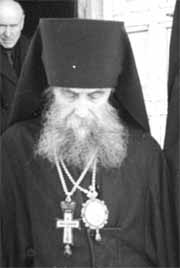 Vladyka Anthony is a catacomb bishop.
Vladyka Anthony is a catacomb bishop.
Bishop
Hilarion
of Smeli
Vladyka Hilarion is a catacomb
bishop in the Ukraine.
Bishop Timothy
of Orenburg
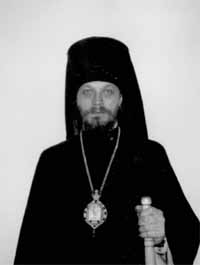 In
the world Anatoly Alexeyevich Sharov, he was born on October 3, 1954, in a
peasant family in the village of Ivanovka, Orenburg province, and graduated from
the historical department of the Orenburg pedagogical institute. In November,
1989, he was ordained to the priesthood by Bishop Gabriel of Khabarovsk (MP). He
served in the town of Magadan, and did a correspondence course in the Moscow
Theological Seminary. He and his community were received into the Free Russian
Orthodox Church in 1991. Archimandrite Timothy witnessed before the Church of
God to his striving, with the help of God, ōto serve the Church even to
confession and martyrdomö, ōfirmly standing for the truth, for the purity of
the Orthodox faithö. On November 24 2000 in the St. Constantine church,
Archbishop Valentine, together with Bishops Theodore, Seraphim, Victor and
Anthony, carried out the hierarchical consecration of Archimandrite Timothy.
In
the world Anatoly Alexeyevich Sharov, he was born on October 3, 1954, in a
peasant family in the village of Ivanovka, Orenburg province, and graduated from
the historical department of the Orenburg pedagogical institute. In November,
1989, he was ordained to the priesthood by Bishop Gabriel of Khabarovsk (MP). He
served in the town of Magadan, and did a correspondence course in the Moscow
Theological Seminary. He and his community were received into the Free Russian
Orthodox Church in 1991. Archimandrite Timothy witnessed before the Church of
God to his striving, with the help of God, ōto serve the Church even to
confession and martyrdomö, ōfirmly standing for the truth, for the purity of
the Orthodox faithö. On November 24 2000 in the St. Constantine church,
Archbishop Valentine, together with Bishops Theodore, Seraphim, Victor and
Anthony, carried out the hierarchical consecration of Archimandrite Timothy.
Vladyka Timothy is serving in the village of Ivanovka, Orenburg
province, in a small church built by him and dedicated to the Holy Trinity. He
publishes an educational leaflet and sometimes send articles for Vertograd-Inform
Information bulletin.
This picture was done in the day of
his consecration. That is why he looks a little bit strange. As a rule he looks
very concentrated.
Bishop
Amvrose
of Khabarovsk
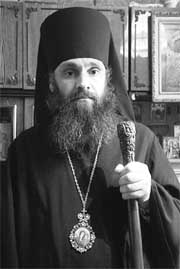 In the world Nicholas Victorovich Epiphanov, he was born on January 29, 1963
in the city of Vyazniki, Vladimir province, and studied in the Gorky Medical
Institute. Then, in 1989, he graduated from the Moscow Theological Seminary, and
on August 28, 1988 was tonsured into monasticism by Archimandrite Eulogy, at
that time prior of Optina desert. He was ordained to the diaconate by Archbishop
Barnabas of Chelyabinsk (MP) on October 10, 1988, and to the priesthood on
November 8, 1989 by Bishop Gabriel of Khabarovsk (MP). From 1989 to 1996
inclusive he served as the superior of churches in the cities of Ussuruisk,
Vladivostok and Khabarovsk, and in the churches in the Astrakhan and Krasnodar
dioceses of the MP. On June 10, 1996 he was retired in accordance with his own
petition. On coming to understand the unrighteousness of sergianism, and the
uncanonicity and heretical nature of the Moscow Patriarchate, he broke communion
with it. On April 29, 2000 he petitioned to be received into the Russian
Orthodox Church.
In the world Nicholas Victorovich Epiphanov, he was born on January 29, 1963
in the city of Vyazniki, Vladimir province, and studied in the Gorky Medical
Institute. Then, in 1989, he graduated from the Moscow Theological Seminary, and
on August 28, 1988 was tonsured into monasticism by Archimandrite Eulogy, at
that time prior of Optina desert. He was ordained to the diaconate by Archbishop
Barnabas of Chelyabinsk (MP) on October 10, 1988, and to the priesthood on
November 8, 1989 by Bishop Gabriel of Khabarovsk (MP). From 1989 to 1996
inclusive he served as the superior of churches in the cities of Ussuruisk,
Vladivostok and Khabarovsk, and in the churches in the Astrakhan and Krasnodar
dioceses of the MP. On June 10, 1996 he was retired in accordance with his own
petition. On coming to understand the unrighteousness of sergianism, and the
uncanonicity and heretical nature of the Moscow Patriarchate, he broke communion
with it. On April 29, 2000 he petitioned to be received into the Russian
Orthodox Church.
On November 26, 2000, in the cathedral church of St. Constantine there took
place the consecration of Archimandrite Ambrose (Epiphanov) as Bishop of
Khabarovsk, a vicariate of the Suzdal diocese of the ROAC. In his sermon at his
naming Archimandrite Ambrose thanked God Who by His ineffable Providence had led
him out of ōthe dead antichristian ecumenist false-churchö into His holy
persecuted Church, which has preserved the purity of the faith ōin woods and
thickets, in houses and basements, in mountains and deserts, in prisons and
exileö ¢ the true Russian Church, which has steeped the Russian land in the
blood of its martyrs, and has filled Paradise with holy confessors and the earth
with holy relics. Vladyka besought the help of God and the prayers of the
Church, which are so necessary to him in the work of gathering the lost sheep
deceived by the false church ōinto one flock, the Holy, Catholic and Apostolic
Churchö.
Bishop
Geronty
of Sukhodolsk
Bishop Geronty (Ryndenko) was born on
May 4, 1946
in the village of Smirnovka, Sumy province (Ukraine). He graduated the
University. In 1995 he was tonsured into monasticism and ordained to the priesthood
by Archbishop Lazar (Zurbenko). Later Hieromonk Geronty along with several
priests applied to be received to ROAC.
On January 24 / February 6 2001 in the St.
Xenia church in the city if Sukhodolsk (Ukraine),
Archbishop Valentine, together with Archbishops Theodore and Bishop Hilarion
carried out the hierarchical consecration of Archimandrite Geronty.

 Metropolitan
Valentine of Suzdal and Vladimir (in the world Anatolij Petrovich Rusantsov) was
born on March 3, 1939 in the Belorechensk town, Krasnodar region. His father
died because of war wounds, mother became seriously ill, and Anatoli was sent to
a orphange, from which he was taken as an adopted son to the family of Ekaterina
Buriak, a member of the Catacomb's Christian Chyrch.
Metropolitan
Valentine of Suzdal and Vladimir (in the world Anatolij Petrovich Rusantsov) was
born on March 3, 1939 in the Belorechensk town, Krasnodar region. His father
died because of war wounds, mother became seriously ill, and Anatoli was sent to
a orphange, from which he was taken as an adopted son to the family of Ekaterina
Buriak, a member of the Catacomb's Christian Chyrch. In
the world Vladimir Alexandrovich Gineyevsky. He was born on April 5, 1955. in
the Kuban in Otradnaya stanitsa. In his childhood he was surrounded by catacomb
Christians. In 1972, in Makhachkape, he got to know Archimandrite Valentine (Rusantsov)
and became his spiritual son and irreplaceable assistant over many years. In
1973, he followed Fr. Valentine to Suzdal, where he was appointed reader in the
Kazan church. In 1976 he was tonsured into monasticism. He was later ordained as
hierodeacon and priest of the St. Constantine cathedral in Suzdal, and then was
raised to the rank of abbot. He took a most active part in the labours of
Archimandrite Valentine in the regeneration of church life in Suzdal.
In
the world Vladimir Alexandrovich Gineyevsky. He was born on April 5, 1955. in
the Kuban in Otradnaya stanitsa. In his childhood he was surrounded by catacomb
Christians. In 1972, in Makhachkape, he got to know Archimandrite Valentine (Rusantsov)
and became his spiritual son and irreplaceable assistant over many years. In
1973, he followed Fr. Valentine to Suzdal, where he was appointed reader in the
Kazan church. In 1976 he was tonsured into monasticism. He was later ordained as
hierodeacon and priest of the St. Constantine cathedral in Suzdal, and then was
raised to the rank of abbot. He took a most active part in the labours of
Archimandrite Valentine in the regeneration of church life in Suzdal. Vladyka Seraphim is a catacomb bishop. Most part of the year he
travels all around Russia, Georgia and other places visiting his parishes. He is
always silent, and he is very modest and simple.
Vladyka Seraphim is a catacomb bishop. Most part of the year he
travels all around Russia, Georgia and other places visiting his parishes. He is
always silent, and he is very modest and simple. Born
in 1944. In 1988 was tonsured
into monasticism. On June 21, 1995 was consecrated a bishop.
Born
in 1944. In 1988 was tonsured
into monasticism. On June 21, 1995 was consecrated a bishop.  Vladyka Anthony is a catacomb bishop.
Vladyka Anthony is a catacomb bishop. In
the world Anatoly Alexeyevich Sharov, he was born on October 3, 1954, in a
peasant family in the village of Ivanovka, Orenburg province, and graduated from
the historical department of the Orenburg pedagogical institute. In November,
1989, he was ordained to the priesthood by Bishop Gabriel of Khabarovsk (MP). He
served in the town of Magadan, and did a correspondence course in the Moscow
Theological Seminary. He and his community were received into the Free Russian
Orthodox Church in 1991. Archimandrite Timothy witnessed before the Church of
God to his striving, with the help of God, ōto serve the Church even to
confession and martyrdomö, ōfirmly standing for the truth, for the purity of
the Orthodox faithö. On November 24 2000 in the St. Constantine church,
Archbishop Valentine, together with Bishops Theodore, Seraphim, Victor and
Anthony, carried out the hierarchical consecration of Archimandrite Timothy.
In
the world Anatoly Alexeyevich Sharov, he was born on October 3, 1954, in a
peasant family in the village of Ivanovka, Orenburg province, and graduated from
the historical department of the Orenburg pedagogical institute. In November,
1989, he was ordained to the priesthood by Bishop Gabriel of Khabarovsk (MP). He
served in the town of Magadan, and did a correspondence course in the Moscow
Theological Seminary. He and his community were received into the Free Russian
Orthodox Church in 1991. Archimandrite Timothy witnessed before the Church of
God to his striving, with the help of God, ōto serve the Church even to
confession and martyrdomö, ōfirmly standing for the truth, for the purity of
the Orthodox faithö. On November 24 2000 in the St. Constantine church,
Archbishop Valentine, together with Bishops Theodore, Seraphim, Victor and
Anthony, carried out the hierarchical consecration of Archimandrite Timothy.  In the world Nicholas Victorovich Epiphanov, he was born on January 29, 1963
in the city of Vyazniki, Vladimir province, and studied in the Gorky Medical
Institute. Then, in 1989, he graduated from the Moscow Theological Seminary, and
on August 28, 1988 was tonsured into monasticism by Archimandrite Eulogy, at
that time prior of Optina desert. He was ordained to the diaconate by Archbishop
Barnabas of Chelyabinsk (MP) on October 10, 1988, and to the priesthood on
November 8, 1989 by Bishop Gabriel of Khabarovsk (MP). From 1989 to 1996
inclusive he served as the superior of churches in the cities of Ussuruisk,
Vladivostok and Khabarovsk, and in the churches in the Astrakhan and Krasnodar
dioceses of the MP. On June 10, 1996 he was retired in accordance with his own
petition. On coming to understand the unrighteousness of sergianism, and the
uncanonicity and heretical nature of the Moscow Patriarchate, he broke communion
with it. On April 29, 2000 he petitioned to be received into the Russian
Orthodox Church.
In the world Nicholas Victorovich Epiphanov, he was born on January 29, 1963
in the city of Vyazniki, Vladimir province, and studied in the Gorky Medical
Institute. Then, in 1989, he graduated from the Moscow Theological Seminary, and
on August 28, 1988 was tonsured into monasticism by Archimandrite Eulogy, at
that time prior of Optina desert. He was ordained to the diaconate by Archbishop
Barnabas of Chelyabinsk (MP) on October 10, 1988, and to the priesthood on
November 8, 1989 by Bishop Gabriel of Khabarovsk (MP). From 1989 to 1996
inclusive he served as the superior of churches in the cities of Ussuruisk,
Vladivostok and Khabarovsk, and in the churches in the Astrakhan and Krasnodar
dioceses of the MP. On June 10, 1996 he was retired in accordance with his own
petition. On coming to understand the unrighteousness of sergianism, and the
uncanonicity and heretical nature of the Moscow Patriarchate, he broke communion
with it. On April 29, 2000 he petitioned to be received into the Russian
Orthodox Church.